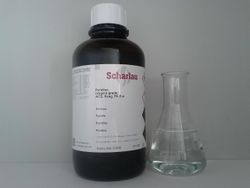Difference between revisions of "Pyridine"
(→Physical) |
|||
| Line 120: | Line 120: | ||
===Physical=== | ===Physical=== | ||
| − | Pyridine is a clear liquid at room temperature with a disagreeable "fishy" odor, described by some as "rotten fish". Pyridine has historically been added to [[ethanol]] to denature it, owing to its very bitter taste. It is miscible with water and polar solvents. It is also | + | Pyridine is a clear liquid at room temperature with a disagreeable "fishy" odor, described by some as "rotten fish". Pyridine has historically been added to [[ethanol]] to denature it, owing to its very bitter taste. It is miscible with water and polar solvents. It is also moderate flammable, with a [[flash point]] of only 17 °C, but an [[autoignition temperature]] far outside the range of those commonly encountered. |
==Acquisition== | ==Acquisition== | ||
Latest revision as of 17:44, 30 November 2022
 Pyridine sample and bottle.
| |

| |
| Names | |
|---|---|
| IUPAC name
Pyridine
| |
| Other names
Azabenzene
Azine | |
| Identifiers | |
| Jmol-3D images | Image |
| |
| Properties | |
| C5H5N | |
| Molar mass | 79.10 g/mol |
| Appearance | Colorless liquid |
| Odor | Nauseating, rotten fish-like |
| Density | 0.9819 g/mL (at 20°C) |
| Melting point | −41.6 °C (−42.9 °F; 231.6 K) |
| Boiling point | 115.2 °C (239.4 °F; 388.3 K) |
| Miscible | |
| Solubility | Miscible with ethanol, diethyl ether, ethyl acetate, DMSO, isopropanol, methanol, petroleum ether |
| Vapor pressure | 16 mmHg (20°C) |
| Acidity (pKa) | 5.25 (for the conjugate acid) |
| Viscosity | 0.88 cP |
| Hazards | |
| Safety data sheet | ScienceLab |
| Flash point | 21 °C |
| Lethal dose or concentration (LD, LC): | |
| LD50 (Median dose)
|
891 mg/kg (rat, oral) 1500 mg/kg (mouse, oral) 1580 mg/kg (rat, oral) |
| LC50 (Median concentration)
|
9000 ppm (rat, 1 hr) |
| Related compounds | |
| Related compounds
|
Aniline Piperidine |
| Except where otherwise noted, data are given for materials in their standard state (at 25 °C [77 °F], 100 kPa). | |
| Infobox references | |
Pyridine, also known as azine, is an organic compound consisting of a benzene ring with one =CH- group being replaced by a nitrogen atom, giving the chemical formula C5H5N.
Contents
Properties
Chemical
Pyridine is a weakly basic due to the lone pair on its nitrogen atom, and forms a stable hydrochloride salt when reacted with hydrochloric acid. It readily forms many coordination complexes with transition metal ions, as do its derivatives, 2,2'-bipyridine and terpyridine. Stronger Lewis bases can be subsituted for these ligands, making these complexes useful precursors.
Pyridine is a useful Lewis base in organic chemistry. It is a precursor to piperidine, another organic building block, which can be prepared by hydrogenation in the presence of a catalyst. In addition, pyridine can function as a polar solvent within which reactions can occur. Pyridinium chlorochromate, produced from pyridine and chromic and hydrochloric acids, can be used to oxidize primary alcohols to aldehydes and secondary alcohols to ketones.
Physical
Pyridine is a clear liquid at room temperature with a disagreeable "fishy" odor, described by some as "rotten fish". Pyridine has historically been added to ethanol to denature it, owing to its very bitter taste. It is miscible with water and polar solvents. It is also moderate flammable, with a flash point of only 17 °C, but an autoignition temperature far outside the range of those commonly encountered.
Acquisition
Pyridine can be purchased, though not cheaply, from several online chemistry suppliers in nearly pure form.
Preparation
Pyridine can be prepared in one route useful to the home chemist by the catalytic decarboyxlation of niacin (nictotinic acid) at the boiling point of pyridine (115.2 °C) using copper chromite, in which pyridine vapor distills off and can be condensed. The copper chromite used is easily produced from copper ammonium chromate (produced from copper sulfate and ammonium dichromate) through strong heating to cause decomposition. The same synthesis may be accomplished at temperatures in excess of 300°C using calcium oxide instead. It is also created by a catalyzed vapor phase reaction between ammonia, formaldehyde, and acetaldehyde.
Pyridine can also be derived by distillation from either coal tar or, historically, bone oil, a product of the destructive distillation of bones which contains several useful reagents if properly separated. However, you will need a large amount of oil, and consequently lots of bones. Fractional distillation is required to purify the compound.
Projects
- Piperidine synthesis
- General solvent
Handling
Safety
Pyridine is toxic and possibly carcinogenic, causing a myriad of health issues if exposure is high. Because it is easily detectable by its strong unpleasant smell and unlikely to be consumed due to its very bitter taste, chances of serious or lethal exposure are low. Pyridine is also very flammable, with a flash point of only 17 degrees. As such, any reactions or use of pyridine should be done away from ignition sources and with proper fire safety equipment on hand.
It is often said that pyridine can cause instant male sterility on intake, but these claims are difficult to substantiate.
Storage
Pyridine should be stored in closed bottles away from any reagents, in a special chemical storage cabinet.
Disposal
Burning pyridine will generate lots of carbon monoxide, soot, VOCs and unburnt pyridine. The resulting smoke will have a putrid smell, which is why, if you want to do this, never do it inside and if you do it outside, avoid populated areas! Diluting it with a more flammable solvent and burning it this way will reduce the smoke odor, though it's best to use an incinerator for this.
Pyridine can be destroyed by adding it dropwise in a fresh solution of Fenton's reagent. Since the oxidation will aerosolize a small amount of pyridine, this is best done outside. As pyridine has a strong and unpleasant smell, do not do this indoors!
Adding water or an acid to pyridine will generate copious amounts of a white mist, which consists of very fine pyridine salt, resulted from the reaction of pyridine and acid vapors. This will adhere to objects, clothes, furniture and will release pyridine in contact with a stronger base.
References
Relevant Sciencemadness threads
- Chemical pages without CAS Registry Number
- Articles without EBI source
- Chemical pages without ChemSpiderID
- Chemical pages without DrugBank identifier
- Articles without KEGG source
- Articles without InChI source
- Articles without UNII source
- Articles containing unverified chemical infoboxes
- Chemical compounds
- Organic compounds
- Aromatic compounds
- Bases
- Lewis bases
- Organic bases
- Solvents
- Polar solvents
- Volatile chemicals
- Foul smelling compounds
- DEA SS List
- Liquids
- Irritants